This week's problem
March 3-10. The integer part of a square vs. the square of an integer part
Problem statement
Spring 2009
February 9-16. A prime and a perfect square
Problem statement
February 2-9. Parity alternating sequences
Problem statement
January 26-February 2. A bouncing ball
Problem statement
Fall 2008
December 1-8. The expected area of a triangle
Problem statement.
Winner: Chuck Goodman
A second solution with an unfortunate small mistake by Nick Olshanskiy.
We have four solutions. Two by Professor Mark Schilling (first solution, second solution), one by Chuck Goodman, and one by the organizers.
November 24-December 1. The number of positive divisors
Problem statement.
No winner this time. A correct yet partially justified solution by Chuck Goodman.
Here is our solution.
November 10-17. The genus of the void cube
Problem statement.
The genus is 5. Here is a solution using Euler's characteristic.
Here is an animated proof.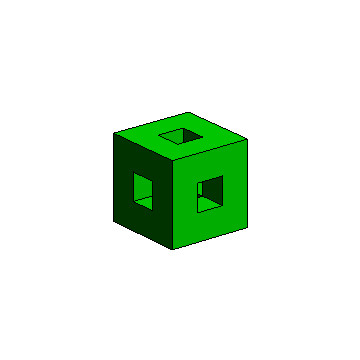
November 3-10. Find the area of the small triangle
Problem statement.
Winner: Nick Olshanskiy
Another correct solution by David Roberts. Here is a solution.
October 27-November 3. A prime number square
Problem statement.
Winner:David Roberts
We also thank Virgilio Cerna, Martha J. Dawiczyk, Chuck Goodman, and Edouard Tchertchian, for all their solutions.
Here are all the correct solutions we received and a project.
October 20-27. A class of polynomials with positive real roots
Problem statement.
Winner:David Roberts
We also thank Virgilio Cerna and Lin Minghua (out of contest, Shaanxi Normal University, China) for their partial solutions. (Both were very close to the complete solution.)
Here is our solution.
October 13-20. The fortune-teller
Problem statement.
Winner: Nick Olshanskiy
Several incorrect solutions were submitted. Here is a correct solution to this problem.
October 6-13. A case when the power of the sum is the sum of the powers.
Problem statement.
No winner this time. Here is a solution to this problem.
September 29-October 6. Finding the celebrity.
Problem statement.
Winner: David Roberts
Other correct solutions by Virgilio Cerna, Jason Johnson, and Nick Olshansky.
Here is the solution.
September 22-29. Always a right angle.
Problem statement.
Winner: Nick Olshanskiy
Here is a solution that only requires elementary geometry (similar triangles).
September 15-22. The square root of a long number.
Problem statement.
Winner: David Roberts
3333....3333, a thousand digits.
Other correct solutions by Prince Ali, Victoria Campbell, Virgilio Cerna, Jared Dozal, Elizabeth Frazier, Torin Gerhart, and Chuck Goodman.
Here is a solution that works for arbitrarily large numbers.
September 8-15. A special number.
Problem statement.
Winner: Liz Frazier
99,965,464,803,644
Other correct solutions by Virgilio Cerna 2,972,042,430,845. Tyler Reifert 99,965,464. David Roberts 996,456,729,024,765,612. (Late submission, out of contest. Larger than the winner's.)
Professor Michael Neubauer sent the largest possible solution, 18 digits, 999,600,729,024,765,612. Thank you.
In fact, there are 450 solutions with 18 digits. Can you find them all? Take a look at our solution.
Back to top.
Spring 2007
April 30-May 7. Find the polynomial.
Problem statement.
April 23-30. A split hexagon.
Problem statement.
March 19-26. Right triangles in a parabola.
Problem statement.
March 12-19. Perfect squares of a quadratic polynomial.
Problem statement.
March 5-12. Modifying an integer.
Problem statement.
February 19-26. The smallest triangular enclosure.
Problem statement.
February 12-19. An inequality for all permutations.
Problem statement.
February 5-12 Never a prime.
Problem statement and solution.
Winner: Chuck Goodman
Back to top.
Fall 2006
December 4-11. Equal length chords.
Problem statement.
November 27-December 4. Guessing the number.
Problem statement.
November 20-27. 101 dwarves.
Problem statement.
November 13-20. The deadline is not a sum of 3 cubes.
Problem statement.
November 6-13. A monochromatic 4-cycle.
Problem statement.
October 30-November 6. An infinite number of powers of 2.
Problem statement.
October 23-30. A property of trapezoids.
Problem statement.
October 16-23. Flying in One-Way Country.
Problem statement.
October 9-16. Only one point with integer coordinates.
Problem statement and solution.
October 2-9. Probability of a good day.
Problem statement and solution.
September 25-October 2. Four collinear points.
Problem statement and solution.
Winner: Krishna Choudhary (9th grade student-out of contest)
September 18-25. Sequence shifts.
Problem statement and solution.
September 11-18. The fashionable spider.
Problem statement and solution.
Back to top.
Spring 2006
May 15-22. Primes written as sums of powers of 2.
Problem statement.
May 8-15. The intersection of a triangle and a square.
Problem statement.
May 1-8. Finding the square of f(1).
Problem statement.
April 24-May 1. Counting derangements.
Problem statement.
April 17-24. Avoiding isosceles triangles.
Problem statement.
April 3-10. A small distance between a square and a cube.
Problem statement and solution.
More about this problem: This problem is a particular case of Catalan's conjecture, now Mihailescu's Theorem: There is only one pair of consecutive positive integers each of which is a perfect power with exponent greater than one. (The unique pair is 8,9.) Catalan conjetured this result in 1844 and Mihailescu proved it in 2002.
March 27-April 3. A geometric identity with rational exponents.
Problem statement and solution.
Winner: George Craciun
The winner's solution uses Analytic Geometry. We also present a synthetic solution.
March 20-27. Maximize the product.
Problem statement and solution.
Winner: Andrew Jones
Incomplete solutions by : Chuck Goodman Shahin Jahangard Cynthia Shepherd Jonathan Yeager.
March 13-20. Tiling a square with squares.
Problem statement and solution.
Winner: Shahin Jahangard
Thank you to CSUN professors Stan Metzenberg (Biology Department), Mark Schilling, and Michael Neubauer (Mathematics Department) who also sent their solutions. These solutions include an example of what is believed to be the smallest number of tiles that are necessary (18).
March 6-13. A self-counting 10-digit number.
Problem statement and solution.
Winner: Richard Abdelkerim
February 27-March 6. Three primes and a fourth power.
Problem statement and solution.
Winner: Marc Missildine
Other correct solution by Richard Abdelkerim and Andrew Jones.
February 20-27. Gnome fashion!
Problem statement and solution.
More about this problem: If you like this problem, think about different number of gnomes. Does the result still holds? What happens if now the houses are painted blue, red, or yellow (3 colors instead of 2)? What about more colors?
February 13-20. An equiangular hexagon.
Problem statement and solution.
Winner: Krishna Choudhary (8th grade student-out of contest)
February 6-13. Abundant numbers.
Problem statement and solution.
Winner: Lucas Lembrik
Other correct solution by : Ezra Schroeder Jason Young
More about this problem: If you like this problem, you can try to find an infinite number of odd abundant numbers. This problem is related to a famous unsolved question. Namely, is there a perfect odd number? (A perfect number is a number which equals the sum of its divisors, excluding itself. For example 28 is perfect because 28=1+2+4+7+14.)
Back to top.
Fall 2005
December 5-12. A characterization of the regular pentagon.
Problem statement and solution.
An incomplete solution by: Jason Hughes.
November 28-December 5. Two equal integer parts.
Problem statement and solution.
Winner: Lucas Lembrick
Other correct and complete solutions by: Daria Alekseyeva, Joseph C. Antone, Kahroliné Maria di Passero, Chuck Goodman, Jason Hughes, Andrew Jones, and Cynthia Shepherd. Click here to see another
A different
solution to this problem.
November 21-28. Solving an equation on two variables.
Problem statement and two solutions, one algebraic and the other using calculus.
A correct and partially justified solution by Lucas Lembrick.
Incomplete solutions by: Joseph C. Antone, Erebooni Aslanian, Jason Hughes, Victor Turcios, and Sajith Wickramaratne.
November 14-21. A disk rotating inside a parabola.
Problem statement and solution.
Winner: Jason Hughes
Other partially correct solution by: Emmanuel Ferrer.
A different solution to this problem.
November 7-14. Rolling a ball to the nearest player.
Problem statement and solution by Jason Hughes (late submission).
October 31-November 7. A property of 2005.
Problem statement and solution.
Winner: Andrew Jones
A partial solution by: Jason Hughes.
Further questions for future research projects.
October 24-31. The "Rectangle" game.
Problem statement and solution.
A partial solution by: Jason Hughes.
Further questions for future research projects.
October 17-24. A geometric inequality for a point in a square.
Problem statement and solution.
Winner: George Craciun
Other solutions by:
Lucas Lembrick and
Mark Joseph.
October 10-17. Each of three numbers divides the sum.
Problem statement and solution.
A partial solution by:
Yigal Darsa.
October 3-10. Roots in arithmetic progression.
Problem statement and solution.
Winner: George Craciun
September 26-October 3. Shuffling two decks.
Problem statement and solution.
Winner: Humberto Raya
September 19-26. Irrational numbers: It stays in the family!
Problem statement and solution.
Additional questions for a future research project.
1. Prove that the problem is still true if we replace six by five. That is, prove that
among any five irrational numbers there are always three of them x, y, z such
that x + y, x + z, y + z are all irrational.
2. Prove that the problem is false if we replace four by six. That is, find four
irrational numbers so that no three of them satisfy that all their pairwise sums
are irrational.
3. Investigate similar questions where instead of asking for three irrational number
we ask for four or more such that (a) all their pairwise sums are irrational, (b)
all the sums in a cycle are irrational.
September 12-19. U find the area!
Problem statement and solution.
Winner: Marcia Ferreira
Other correct solutions by: Mark Joseph Juan Pilar.
An almost correct solution by: Richard Abdelkerim.
A partially justified solution by : George Gomes.
We also have an alternative "graphic" no-words-solution.
September 5-12. How many ways to get there?
Problem statement and solution.
Winner: Lucas Lembrik
Back to top.
Spring 2005
May 9-16. First non-zero digit of square root x.
Problem statement and solution.
Partial solutions by : Paul A. Ryan and George Craciun.
May 2-9. Numbers having small prime factors.
Problem statement and solution.
Partial solution by Paul A. Ryan.
April 25-May 2. Find the volume.
Problem statement and solution.
Winner: Barbara Falkowski
Other correct solution by Paul A. Ryan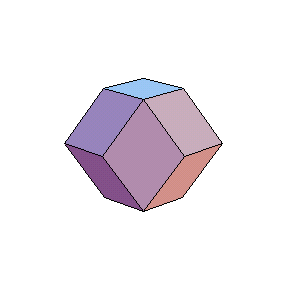
April 18-25. A sequence of points.
Problem statement and solution.
Winner: Marcia Ferreira
Other correct solutions by: John Paul Philips and Boian Djonov.
Correct but partially justified solution by: William Rutan.
April 11-18. The derivative of a product.
Problem statement and solution.
Winner: Humberto Raya
Other correct solutions by: Robert Reiner and Paul A. Ryan .
April 4-11. 33 segments in a digital watch.
Problem statement and solution.
Winner: Robert Reiner winner's solution
Other correct solutions by: Yigal Darsa, Eric Rodighiero, and Samira Sadrarhami.
Other incomplete solutions by: Otilia Gonzales, Khudija Jamil, Paul Ryan, Chris Turcato, and Darrell Walls Further questions for future research projects.
March 28-April 4. The sum is never 100.
Problem statement and solution.
Winner: Barbara Falkowski
Other correct solutions by: Richard Abdelkerim, George Craciun, and Paul Ryan.
Three different solutions to this problem, one by Paul Ryan.
March 14-21. 1-2-3 tangent circles.
Problem statement and solution.
March 7-14. Covering dots.
Problem statement and solution.
Further questions for future research projects.
February 28-March 7. A hungry hamster.
Problem statement and solution.
Winner: Barbara Falkowski
February 21-28. A 2005 diophantine equation.
Problem statement and solution.
Winner: Boian Djonov
February 14-21. Roots vs critical points.
Problem statement and solution.
Winner: Robert Reiner
Other correct solutions by: George Craciun.
February 7-14. Tables with the same check.
Problem statement and solution.
An incomplete solution by : Samira Sadrarhami.
Jabuary 31-February 7. How much chocolate?
Problem statement and solution.
Winner: Humberto Raya
Other correct solutions by : George Craciun, Yigal Darsa, Jeffrey Liu, Robert Reiner.
Back to top.
Fall 2004
November 15-22. The maximum of an a,b,c expression.
Problem statement and solution.
Winner: George Craciun winner's solution
Other correct but partially justified solution by Jennifer Goldenberg.
November 8-15. The prime must be 3.
Problem statement and solution.
Winner: Chuck Goodman
Other correct and complete solutions by Jeffrey Liu More about this problem: Click here to see
Further questions for future research projects.
November 1-8. What is the angle?
Problem statement and solution.
Winner: Yuko Takagi winner's solution
Other correct and complete solutions by Boian Djonov and Jeffrey Liu.
Other correct but partially justified solution by Barbara Falkowski.
A different solution to this problem by Jeffrey Liu.
We would like to thank Miroslav Tanushev for proposing this beautiful problem.
October 25-November 1. A circular chain of dominos.
Problem statement and solution.
Winner: Chris Dungan
Excel file with explanation.
F
urther questions for future research projects.
October 18-25. A triangular billiard table.
Problem statement and solution.
Winner: Jeffrey Liu
Further questions for future research projects.
October 11-18. Finding a function.
Problem statement and solution.
Winners: George Craciun & John Foss winners
Further questions for future research projects.
October 4-11. Turning lights on and off.
Problem statement and solution.
Winner: Chris Dungan
Other correct and complete solutions by Boian Djonov, Khudija Jamil, and Joseph Viner.
We would like to thank Ann & Bill Watkins for donating the book awarded this week.
![]()
September 27-October 4. Rearranging the pieces.
Problem statement and solutions.
September 20-27. Half my father's age.
Problem statement and solution.
Winner: Boian Djonov
Other correct and complete solution by Chris Dungan. More about this problem: Click here for an alternative
A different
solution by Chris Dungan.
We would like to thank Ann & Bill Watkins for donating the book awarded this week.
September 13-20. Ants falling off a stick.
Problem statement and solution.
Winner: Robert Reiner
Other correct and complete solutions by Boian Djonov, Chris Dungan, and John Foss.
A different solution by Chris Dungan.
We would like to thank Ann & Bill Watkins for donating the book awarded this week.
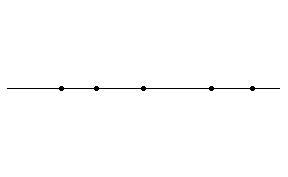
September 6-13. The cubic root of a matrix.
Problem statement and solution.
Winner: Chuck Goodman

Other correct and complete solutions by Farzad Ghassemi, Robert C. Reiner, and Takumi Saegusa.
Other correct but partially justified solution by Will Yessayan.
A different solution to this problem.
Further questions for future research projects.
We would like to thank Ann & Bill Watkins for donating the book awarded this week.
August 30-September 6. Integer values of a quotient.
Problem statement and solution.
Winner: Chris Dungan

Other correct and complete solution by Khudija S. Jamil.
Other correct but incomplete solutions: Boian Djonov and Farzad Ghassemi.
August 23-30. How high is the fifth basketball.
Problem statement and solution.
Winner: Joseph Viner
Other correct and complete solutions by Hasan Adil, Alan Cheng, Christopher Dungan, Barbara Falkowski, Spencer Kam, Jeffrey Liu, Robert Reiner, and Will Yessayan.
A different solution by Jeffrey Liu.
Back to top.
Spring 2004
May 17-24. Tracking a turtle's path.
Problem statement.
May 10-17. A broken chain of divisors.
Problem statement and solution.
Correct and complete solution by Farzad Ghassemi (out of contest).
Other crrect and partially justified solutions by Dani Elias and Barbara Falkowski
A different solution based on Farzad Ghassemi's. This solution classifies all pairs (a,b) satisfying the conditions of the problem.
May 3-10. Stay ahead!
Problem statement and solution.
Winner: Boian Djonov
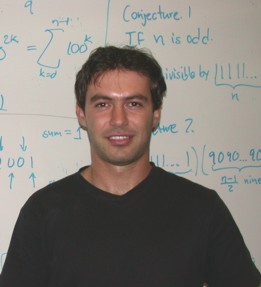
Other incomplete solutions by Barbara Falkowski and Spencer Kam.
Two different solutions to this problem.
April 26-May 3. There is always a small triangle.
Problem statement and solution.
Winner: Takumi Saegusa
Other correct and complete solutions by Boian Djonov and Farzad Ghassemi.
Further questions for future research projects.
We would like to thank Ann & Bill Watkins for donating the book awarded this week.
April 19-26. A calling-numbers game strategy.
Problem statement and solution.
Winner: Robert Reiner

Other correct and complete solutions by Boian Djonov, Dani Elias, Barbara Falkowski, Gregory Hakhamov, Spencer Kam, Vitaley Kovalev, Takumi Saegusa, and Prashant Saraswat
A different solution by Prashant Saraswat.
We would like to thank Magnhild Lien for donating the T-shirt awarded this week.
April 12-19. A polynomial with four real roots.
Problem statement and solution.
Winner: Takumi Saegusa
A different solution.
Further questions for future research projects.
We would like to thank Magnhild Lien for donating the T-shirt awarded this week.
March 29-April 5. Switching dollars and cents.
Problem statement and solution.
Winner: Barbara Falkowski

Other correct and complete solution by Staci Ann Pearson.
Other correct and partially justified solutions by Dani Elias and Larisa Medovaya.
More about this problem: This problem is related to the theory of Diophantine Equations.
A classical solution that can be used in a more general setting.
More on Diophantine equations.
We would like to thank Bill Watkins for proposing this beautiful problem.
March 22-29. Triangles of equal area.
Problem statement and solution.
Winner: Takumi Saegusa
Other correct and complete solutions by Grigor Badalyan, Barbara Falkowski, and Prashant Saraswat.
March 15-22. The sum of a series.
Problem statement and solution.
Winner: Takumi Saegusa
Other correct and complete solutions by Blake Barley, Khudija Jamil & Jennifer Wright, Robert Reiner, and Prashant Saraswat.
Other correct and partially justified solutions by Alicia Maravillaand Patrick C Gass.
Further questions for future research projects.
March 8-15. Dividing a group into perfect squares.
Problem statement and solution.
Winner: Takumi Saegusa
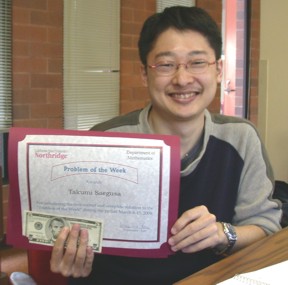
Other correct and complete solutions by Richard Abdelkerim and Prashant Saraswat.
Other correct and partially justified solutions by Hasan Adil, Khudija Jamil and Michele Miller.
An alternative "graphic" solution.
Further questions for future research projects.
Back to top.
